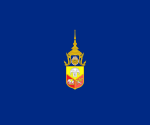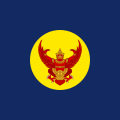Prajadhipok
Prajadhipok (Thai: ประชาธิปก; RTGS: Prachathipok; 8 November 1893 – 30 May 1941), reigning title Phra Pok Klao Chao Yu Hua, also Rama VII, was the seventh monarch of Siam of the Chakri dynasty. He was the last absolute monarch and the first constitutional monarch of the country. His reign was a turbulent time for Siam due to political and social changes during the Revolution of 1932. He is to date the only Siamese monarch of the Chakri Dynasty to abdicate.
| Prajadhipok พระบาทสมเด็จพระปกเกล้าเจ้าอยู่หัว | |
|---|---|
| King Rama VII | |
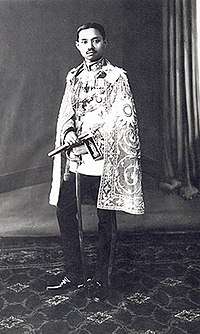 | |
| King of Siam | |
| Reign | 25 November 1925 – 2 March 1935 |
| Coronation | 25 February 1926 |
| Predecessor | Vajiravudh (Rama VI) |
| Successor | Ananda Mahidol (Rama VIII) |
| Prime Ministers | See list
|
| Born | 8 November 1893 Grand Palace, Bangkok, Siam |
| Died | 30 May 1941 (aged 47) Surrey, England |
| Burial | 3 June 1941 Golders Green Crematorium, London, England |
| Spouse | Rambai Barni |
| House | Chakri Dynasty |
| Father | Chulalongkorn (Rama V) |
| Mother | Saovabha Phongsri |
| Religion | Buddhism |
| Signature |  |
| Prajadhipok | |
|---|---|
.svg.png) Privy Seal | |
| Thai name | |
| Thai | ประชาธิปก |
| RTGS | Prachathipok |
Early life

Somdet Chaofa Prajadhipok Sakdidej (Thai: สมเด็จเจ้าฟ้าประชาธิปกศักดิเดชน์) was born on 8 November 1893 in Bangkok, Siam (now Thailand) to King Chulalongkorn and Queen Saovabha Phongsri. Prince Prajadhipok was the youngest of nine children born to the couple. Overall he was the king's second-youngest child (of a total of 77), and the 33rd and youngest of Chulalongkorn's sons.[1]
Unlikely to succeed to the throne, Prince Prajadhipok chose to pursue a military career. Like many of the king's children, he was sent abroad to study, going to Eton College in 1906, then to the Woolwich Military Academy from which he graduated in 1913. He received a commission in the Royal Horse Artillery in the British Army based in Aldershot. In 1910 Chulalongkorn died and was succeeded by Prajadhipok's older brother (also a son of Queen Saovabha), Crown Prince Vajiravudh, who became King Rama VI. Prince Prajadhipok was by then commissioned in both the British Army and the Royal Siamese Army. With the outbreak of the First World War and the declaration of Siamese neutrality, King Vajiravudh ordered his younger brother to resign his British commission and return to Siam immediately, a great embarrassment to the prince, who wanted to serve with his men on the Western front. Once home, Prajadhipok became a high-ranking military official in Siam. In 1917 he was ordained temporarily as a monk,[2]:30 as was customary for most Buddhist Siamese men.
In August 1918 Prince Prajadhipok married his childhood friend and cousin Rambhai Barni, a descendant of King Mongkut (Prajadhipok's grandfather) and his Royal Consort Piam. They were married at Sukhothai Palace which was a wedding gift to the couple from Queen Saovabha.[1]
After the war in Europe ended, he attended the École Superieure de Guerre in France, returning to Siam to the Siamese military. During this time, he was granted the additional title Krom Luang Sukhothai (Prince of Sukhothai). Prajadhipok lived a generally quiet life with his wife at their residence, Sukhothai Palace, next to the Chao Phraya River. The couple had no children. Prajadhipok soon found himself rising rapidly in succession to the throne, as his brothers all died within a relatively short period. In 1925, King Vajiravudh himself died at the age of 44. Prajadhipok became absolute monarch at only thirty-two. He was crowned King of Siam on 25 February 1926.
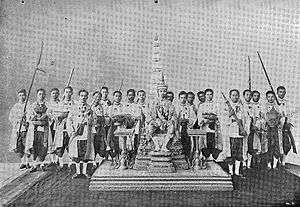
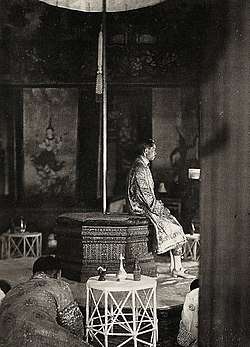
Last absolute monarch
Relatively unprepared for his new responsibilities, Prajadhipok was nevertheless intelligent, diplomatic in his dealings with others, modest, and eager to learn.[3]:235 However, he had inherited serious political and economic problems from his predecessor.[2]:30 The budget was heavily in deficit, and the royal financial accounts were in serious disorder. The entire world was in the throes of the Great Depression.
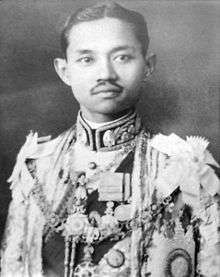
In an institutional innovation intended to restore confidence in the monarchy and government, Prajadhipok, in what was virtually his first act as king, announced the creation of the Supreme Council of the State of Siam. This council was made up of five experienced members of the royal family, although to emphasise the break with the previous reign the selected five had all fallen out of favour with the previous monarch.[2]:31 The council thus comprised three of the king's uncles, Prince Bhanurangsi, Prince Naris and Prince Damrong Rajanubhab and two of his half-brothers, Prince Kitiyakon (Prince Chantaburi) and Prince Boriphat.[4]:253
Many of the Princes of the Supreme Council felt that it was their duty to make amends for the mistakes of the previous reign, but their acts were not generally appreciated, for the government failed to communicate to the public the purpose of the policies they pursued to rectify Vajiravudh's extreme financial extravagances.[5] Gradually these princes arrogated power to themselves, monopolising all the main ministerial positions and appointing their sons and brothers to both administrative and military posts. By April 1926 almost the entire cabinet of ministry heads had been replaced with newly appointed Princes or nobles, with only three former members being re-appointed.[4]:254 While the family appointments brought back men of talent and experience, they also signalled a return to royal oligarchy.
The king clearly wished to demonstrate a clear break with the discredited sixth reign, and his choice of men to fill the top positions appeared to be guided largely by a wish to restore a Chulalongkorn-type government.[4] Unlike his predecessor, the king read virtually all state papers that came his way, from ministerial submissions to petitions by citizens.[4]:255 The king was painstaking and conscientious; he would elicit comments and suggestions from a range of experts and study them, noting the good points in each submission, but when various options were available he would seldom be able to select the best one and abandon others. He would often rely upon the Supreme Council to prod him in a particular direction.[4]:254
From the beginning of his reign King Prajadhipok was acutely aware that political change was necessary if the monarchy was to be preserved.[2]:130 He viewed his newly established Supreme Council as an institutional check upon the powers of an absolute monarch.[2]:130 During 1926, Prajadhipok experimented with using the Privy Council, which had over 200 members at that time, as a quasi-legislative body.[2]:134 This large of an assembly proved too cumbersome, and in 1927 Prajadhipok created the Committee of the Privy Council consisting of 40 members selected from the royal family or nobility.[2]:135 The committee was received positively by the press and was envisaged as a forerunner of a parliament or National Assembly.[2]:137–139 In practice however the committee remained relatively unimportant and sadly did not develop into a more powerful or representative body.[2]:137
In 1926 Prajadhipok wrote a lengthy memorandum to his American adviser Francis B. Sayre titled "Problems of Siam" in which he set forth nine questions he felt were the most serious facing the nation. The third question asked whether Siam should have a parliamentary system, which Prajadhipok doubted. The fourth question asked whether Siam was ready for representative government, to which Prajadhipok answered "my personal opinion is an emphatic NO".[2]:38 However, the king did see a possibility to introduce reform at the local level as the "next step in our educational move towards democracy".[2]:140 In 1926 he began moves to develop the concept of prachaphiban, or "municipality", which had emerged late in the fifth reign as a law regarding public health and sanitation.[6] Information was obtained regarding local self-government in surrounding countries, and proposals to allow certain municipalities to raise local taxes and manage their own budgets were drawn up. The fact that the public was not sufficiently educated to make the scheme work militated against the success of this administrative venture. Nevertheless, the idea of teaching the Siamese the concept of democracy through a measure of decentralisation of power in municipalities had become, in Prajadhipok's mind, fundamental to future policy-making.[2]
In September 1931 Britain abandoned the gold standard and devalued sterling by 30 percent.[4]:259 This created a crisis for Siam since most of its foreign exchange was held in sterling.[2]:195 The Minister of Finance kept Siam on the gold standard by linking the currency to the US dollar, but debate about this policy raged within the government into 1932.[2]:195–196 One impact of this policy was that Siam's rice exports became more expensive than competitor exporters, negatively impacting revenue.[3]:240
In mid-October 1931 the king returned from a trip to Canada and the US and ordered Prince Devawongse Varoprakar, the Minister of Foreign Affairs to prepare a constitution. The task of drafting this document was given to the American Raymond B. Stevens and Phaya Sri Wisarn Waja.[2]:148 In March the following year they submitted an "Outline of Changes in the Form of Government" together with their comments[2]:149. Prajadhipok originally planned to announce the new constitution to the nation of 6 April at the opening of the Memorial Bridge to commemorate the 150th anniversary of the Chakri dynasty.[2]:150 These proposals met strong opposition from Prince Damrong and other royal members of the Supreme Council and despite his own misgivings that to not proceed would result in a coup against his government, the king ultimately did not make the planned announcement.
On 20 January 1932, with the country deep in depression, the king convened a "round table" meeting to discuss the many competing arguments and to agree on how to tackle the crisis.[2]:204 From this meeting it was agreed to make large cuts in government spending and implement a retrenchment programme. Two weeks later on 5 February the king addressed a group of military officers and spoke at length about the economic situation. In this speech he remarked "I myself know nothing at all about managing finances, and all I can do is listen to the opinions of others and choose the best...If I have made a mistake, I believe I really deserve to be excused by the people of Siam."[2]:204 No previous monarch had ever spoken so honestly.[2]:205 The speech was widely reported and many interpreted his words not as a frank appeal for understanding and cooperation, but as a sign of weakness and proof that the system of rule of fallible autocrats should be abolished.[7]
Revolution of 1932

A small group of soldiers and civil servants began secretly plotting to overthrow absolute monarchy and bring a constitutional government to the kingdom. Their efforts culminated in an almost bloodless "revolution" on the morning of 24 June 1932 by the self-proclaimed Khana Ratsadon (People's Party; คณะราษฎร).[4]:262 While Prajadhipok was away at Klai Kangwon Palace in Hua Hin, the plotters took control of the Ananda Samakhom Throne Hall in Bangkok and arrested key officials (mainly princes and relatives of the king).[4]:262 The People's Party demanded Prajadhipok become a constitutional monarch and grant Thai people a constitution. In the event of a negative response, they reserved the right to declare Siam a republic. The king immediately accepted the People's Party's request and the first "permanent" constitution of Siam was promulgated on 10 December.[4]:263
Prajadhipok returned to Bangkok on 26 June and received the coup plotters in a royal audience. As they entered the room, Prajadhipok greeted them, saying "I rise in honour of the Khana Ratsadorn."[8][9] It was a significant gesture because, according to previous royal rituals, monarchs were to remain seated while their subjects made obeisance. Prajadhipok was acknowledging the changed circumstances. Absolute monarchy was finished.[5]
First constitutional monarch
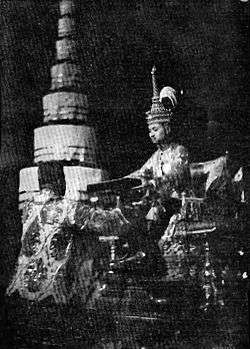
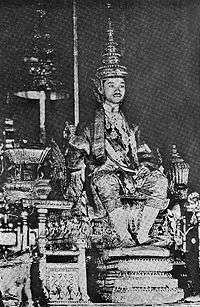

The king's relations with the People's Party deteriorated quickly, particularly after the ousting of Phraya Manopakorn Nititada as prime minister by the Khana Ratsadon's leader Phraya Phahol Phonphayuhasena.
In October 1933, the maverick Prince Boworadej, a popular former minister of defence who had resigned from Prajadhipok's cabinet in protest over the budget cuts, led an armed revolt against the government. In the Boworadet Rebellion, he mobilised several provincial garrisons and marched on Bangkok, occupying the Don Muang aerodrome. Prince Boworadej accused the government of being disrespectful to the monarch and of promoting communism, and demanded that government leaders resign. Boworadej had hoped that garrisons in the Bangkok would support him, but their commander ensured that they remained loyal to the government. The Royal Thai Navy declared itself neutral and left for its bases in the south. After heavy fighting near Don Muang, the ammunition-short Boworadej forces were defeated and the prince himself fled to exile in French Indochina.
There is no evidence that Prajadhipok gave any support to the rebellion.[2][3] Nevertheless, the insurrection diminished the king's prestige. When the revolt began, Prajadhipok immediately informed the government that he regretted the strife and civil disturbances. The royal couple then took refuge at Songkhla, in the far south. The king's withdrawal from the scene was interpreted by the Khana Ratsadorn as a failure to do his duty. By not throwing his full support behind government forces, he had undermined their trust in him.[2]
In 1934 the Assembly voted to amend civil and military penal codes. One of the proposed changes would allow death sentences to be carried out without the king's approval.[10] The king protested, and in two letters submitted to the Assembly said that ending this time-honoured custom would make the people think that the government desired the right to sign death warrants to eliminate political opponents. As a compromise he proposed holding a national referendum on the issue.[11]
Many in the Assembly were angered. They felt the king was implying that the Assembly did not actually represent the will of the people and voted to re-affirm the penal code changes.[12]
Prajadhipok, whose relations with the Khana Ratsadorn had been deteriorating for some time, went on a tour of Europe before visiting England for medical treatment. He continued to correspond with the government regarding the conditions under which he would continue to serve. As well as retaining some traditional royal prerogatives, such as granting pardons, he was anxious to mitigate the increasingly undemocratic nature of the new regime.[3] Agreement was reached on the penal codes, but Prajadhipok indicated he was unwilling to return home until guarantees were made for his safety, and the constitution was amended to make the Assembly an entirely elected body. The government refused to comply, and on 14 October Prajadhipok announced his intention to abdicate unless his requests were met.
King Prajadhipok's trip to Europe
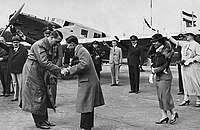 King Prajadhipok and Adolf Hitler at Berlin Tempelhof Airport in Nazi Germany, 1934
King Prajadhipok and Adolf Hitler at Berlin Tempelhof Airport in Nazi Germany, 1934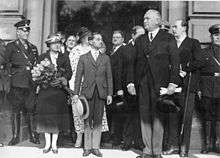 King Prajadhipok and Queen Rambhai Barni with Konstantin von Neurath in Nazi Germany, 1934
King Prajadhipok and Queen Rambhai Barni with Konstantin von Neurath in Nazi Germany, 1934
Abdication

The People's Party rejected the ultimatum, and on 2 March 1935, Prajadhipok abdicated, to be replaced by Ananda Mahidol. Prajadhipok issued a brief statement criticising the regime that included the following phrases, since often quoted by critics of Thailand's slow political development.
I am willing to surrender the powers I formerly exercised to the people as a whole, but I am not willing to turn them over to any individual or any group to use in an autocratic manner without heeding the voice of the people.
As an idealistic democrat, the former king had good grounds for complaint.[4] The Executive Committee and Cabinet did not seem eager to develop an atmosphere of debate or to be guided by resolutions of the Assembly.
Reaction to the abdication was muted. Everybody was afraid of what might happen next. The government refrained from challenging any assertions in the king's abdication statement for fear of arousing further controversy. Opponents of the government kept quiet because they felt intimidated and forsaken by the king whom they regarded as the only person capable of standing up to the regime. In other words, the absolutism of the monarchy had been replaced by that of the People's Party, with the military looming in the wings as the ultimate arbiter of power.[5]
Life after abdication and death

Prajadhipok spent the rest of his life with Queen Rambhai Barni in England. At the time of abdication, the couple lived at Knowle House, in Surrey, just outside London. However, this house was not suitable considering his health, so they moved to a smaller house in Virginia Water (still in Surrey), but with more space. The house was named "Hangmoor", but wishing to give it a more pleasant name, he called it "Glen Pammant", an anagram of an old Thai phrase tam pleng nam. They remained there for two years. The couple had no children, but adopted the youngest son of Prince Bhanurangsi Savangwongse, (one of King Chulalongkorn's full brother).
The adopted son, Prince Suprabhat Chirasakti (or Jirasakdi), would later serve as a pilot in Britain's Air Transport Auxiliary during the Second World War, with the rank of Second Officer (S/O). He died on Saturday, 12 September, 1942, while delivering a Hawker Sea Hurricane IIC (JS346) from RAF Kirkbride aerodrome near Kirkbride, Cumbria.[13][14] S/O Prince Prince Chirasakti, known as Cherry by his friends in the ATA, took off along with F/O Forbes (a volunteer from the United States) in very cloudy conditions shortly after 1200 Hrs and flew northward. Forbes returned alone within fifteen minutes. S/O Prince Chirasakti was reported overdue at his destination (Arbroath) at 18:00 Hrs. By midnight it had been learnt that he had crashed into a hill near Eweslees Farm, Langholm, in Scotland. He had entered a blind valley in low cloud, tried to turn, flew into a hill and was killed. He had his flaps down, and was not flying very fast. "Just fast enough to kill him," the investigating officer reported to his colleagues. His friend, Third Officer Roy William Reisert (another American volunteer who had trained for the RAF at the Bermuda Flying School before joining the ATA) and F/O Davy were given the task of clearing his personal effects from his locker at RAF Kirkbride. Reisert wrote I picked up the large brown and white calf-skin purse which he prized and often carried--and dropped it in the box for shipment to his homeland--Siam. S/O Prince Chirasakti's funeral was held at Golder's Green Crematorium in London on Wednesday, 16 September. Reisert flew over his crash site in a Fairchild Argus on the same day.[15] The funeral service was conducted with Buddhist rites by a Buddhist priest, with a guard of honour provided by the Royal Air Force and colleagues from the Air Transport Auxiliary. The funeral was attended by Queen Rambhai Barni of Thailand, Prince Abbhas, Prince Birabongse Bhanudej, Mani Xenier Bunnag, Captain and Mrs JB Wyndham, the Earl of Derby, Captain HJ Stocks (Flying Establishment Officer, ATA, representing the RAF) and Flight Lieutenant J Gallatly (representing the ATA).[16]
They moved again to Vane Court, the oldest house in the village of Biddenden in Kent. He led a peaceful life there, gardening in the morning and writing his autobiography in the afternoon.
In 1938 the royal couple moved to Compton House, in the village of Wentworth in Virginia Water, Surrey.
Due to bombing by the German Luftwaffe in 1940, the couple again moved, first to a small house in Devon, and then to Lake Vyrnwy Hotel in Powys, Wales, where the former king suffered a heart attack.
The couple returned to Compton House, as he expressed his preference to die there. King Prajadhipok died from heart failure on 30 May 1941.
His cremation was held at the Golders Green Crematorium in north London.[17] It was a simple affair attended by just Queen Ramphai and a handful of close relatives. Queen Ramphaiphanni stayed at Compton House for a further eight years before she returned to Thailand in 1949, bringing the king's ashes back with her.[18]
Legacy
Among the recent Chakri monarchs, particularly Chulalongkorn and Bhumibol, Prajadhipok emerged with relatively little revisionistic detraction. He was a hard-working, effective administrator who was intellectually equal to the demands of his office, and whose main failing was to underestimate the Bangkok elite's growing demand for power. As late as his death in exile, many, as the historian David K. Wyatt puts it, "would have agreed with his judgement that a move towards democracy in 1932 was premature."[3]
Tributes to Prajadhipok
 A Statue of the king in Sukhothai Thammathirat Open University, Nonthaburi
A Statue of the king in Sukhothai Thammathirat Open University, Nonthaburi.jpg) King Rama VII statue at Parliament House of Thailand
King Rama VII statue at Parliament House of Thailand
| Monarchs of the Chakri dynasty | |
|---|---|
| Phra Buddha Yodfa Chulaloke (Rama I) | |
| Phra Buddha Loetla Nabhalai (Rama II) | |
| Nangklao (Rama III) | |
| Mongkut (Rama IV) | |
| Chulalongkorn (Rama V) | |
| Vajiravudh (Rama VI) | |
| Prajadhipok (Rama VII) | |
| Ananda Mahidol (Rama VIII) | |
| Bhumibol Adulyadej (Rama IX) | |
| Vajiralongkorn (Rama X) | |
Titles, styles and honours
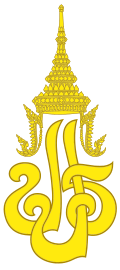
Titles and styles
As monarch, Prajadhipok was referred to by his reigning name of Phrabat Somdet Phra Pokklao Chao Yuhua (พระบาทสมเด็จพระปกเกล้าเจ้าอยู่หัว) and in legal documents was a more formal Phrabat Somdet Phra Poraminthra Maha Prajadhipok Phra Pokklao Chao Yuhua (พระบาทสมเด็จพระปรมินทรมหาประชาธิปก พระปกเกล้าเจ้าอยู่หัว)
Thais today usually call him Ratchakan thi Chet (lit. "The Seventh Reign") or more colloquially, Phra Pok Klao (พระปกเกล้า), and in English, King Rama VII. The system of referring to Chakri rulers as "Rama" (followed by a number) was instituted by King Vajiravudh to follow European practice.
National honours
_ribbon.svg.png)
_ribbon.svg.png)
_ribbon.svg.png)
Foreign honours





Ancestry
| Ancestors of Prajadhipok | |||||||||||||||||||||||||||||||||||||||||||||||||||||||||||||||||||||||||||||||||||||||||||||||||||||||||||||||||||||||||||||||||||||||||||||||||||||||||||||||||||||||||||||||||||||||||||||||||||||||||||||||||||||||||||||||||||||||||||||||||||||||||||||||||||||||||||||||||||||||||
|---|---|---|---|---|---|---|---|---|---|---|---|---|---|---|---|---|---|---|---|---|---|---|---|---|---|---|---|---|---|---|---|---|---|---|---|---|---|---|---|---|---|---|---|---|---|---|---|---|---|---|---|---|---|---|---|---|---|---|---|---|---|---|---|---|---|---|---|---|---|---|---|---|---|---|---|---|---|---|---|---|---|---|---|---|---|---|---|---|---|---|---|---|---|---|---|---|---|---|---|---|---|---|---|---|---|---|---|---|---|---|---|---|---|---|---|---|---|---|---|---|---|---|---|---|---|---|---|---|---|---|---|---|---|---|---|---|---|---|---|---|---|---|---|---|---|---|---|---|---|---|---|---|---|---|---|---|---|---|---|---|---|---|---|---|---|---|---|---|---|---|---|---|---|---|---|---|---|---|---|---|---|---|---|---|---|---|---|---|---|---|---|---|---|---|---|---|---|---|---|---|---|---|---|---|---|---|---|---|---|---|---|---|---|---|---|---|---|---|---|---|---|---|---|---|---|---|---|---|---|---|---|---|---|---|---|---|---|---|---|---|---|---|---|---|---|---|---|---|---|---|---|---|---|---|---|---|---|---|---|---|---|---|---|---|---|---|---|---|---|---|---|---|---|---|---|---|---|---|---|---|---|
| |||||||||||||||||||||||||||||||||||||||||||||||||||||||||||||||||||||||||||||||||||||||||||||||||||||||||||||||||||||||||||||||||||||||||||||||||||||||||||||||||||||||||||||||||||||||||||||||||||||||||||||||||||||||||||||||||||||||||||||||||||||||||||||||||||||||||||||||||||||||||
See also
- King Prajadhipok Museum
- Siamese coup d'état of 1932
- History of Thailand (1932-1973)
External links
- King Prajadhipok's Institute
- Prajadhipok's coronation at YouTube by the Thai Film Archive
- Newspaper clippings about Prajadhipok in the 20th Century Press Archives of the ZBW
References
| Wikimedia Commons has media related to Prajadhipok. |
- Bhorombhakdi, Soravij. "HM King Prajadhipok". The Siamese Royalty A Personal Fascination. Retrieved 20 October 2018.
- Batson, Benjamin. (1984) The End of the Absolute Monarchy in Siam. Oxford University Press.
- Wyatt, David K. (1982) Thailand: A Short History. New Haven.
- Terwiel, B.J. (2005) Thailand's Political History: From the Fall of Ayutthaya to Recent Times. River Books.
- Stowe, Judith A. (1990) Siam Becomes Thailand. Hurst & Company.
- Sonthi Techanan (1976) Plans for Democratic Development in the Seventh Reign. Kasetsart University.
- Vella, Walter (1955) The Impact of the West on Government in Thailand. University of California Press.
- Thawatt Mokarapong. (1972) History of the Thai Revolution. Chalermnit.
- Pridi Phanomyong (1974) Ma vie mouvementée. Paris.
- Bangkok Times Weekly Magazine (22 August 1934).
- Sivaram, M. (1936) The New Siam in the Making. Bangkok.
- Bangkok Times Weekly Magazine (1 October 1934).
- [https://www.forgottenairfields.com/airfield-kirkbride-963.html ABANDONED FORGOTTEN & LITTLE KNOWN AIRFIELDS IN EUROPE: RAF KirkBride
- Solway Military Trail: RAF Kirkbride
- Old Pilots Never Die They Just Fly Away, by Roy William Reisert. Published on demand by Trafford Publishing, 6E-2333 Government Street, Victoria, British Columbia, Canada V8T 4P4. 2005. ISBN 1-4120-5192-4
- The Times, London, 17 September, 1942
- https://www.silpa-mag.com/old-photos-tell-the-historical-story/article_12544
- https://lifestyle.campus-star.com/knowledge/88087.html
- http://www.ratchakitcha.soc.go.th/DATA/PDF/2468/D/2746.PDF
- http://www.ratchakitcha.soc.go.th/DATA/PDF/2468/D/2747.PDF
- http://www.ratchakitcha.soc.go.th/DATA/PDF/2468/D/2750.PDF
- Jørgen Pedersen (2009). Riddere af Elefantordenen, 1559–2009 (in Danish). Syddansk Universitetsforlag. p. 470. ISBN 978-87-7674-434-2.
- Mémorial du centenaire de l'Ordre de Léopold. 1832–1932. Bruxelles, J. Rozez, 1933.
Prajadhipok Chakri Dynasty Born: 8 November 1893 Died: 30 May 1941 | ||
| Preceded by Vajiravudh |
King of Siam 1925–1935 |
Succeeded by Ananda Mahidol |
_of_Siam.jpg)
.svg.png)
